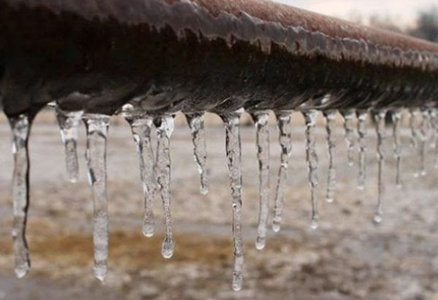||| FROM EASTSOUND WATER |||
We hope you had a great holiday and are thriving during this cold weather spell we’ve been having.
This is a fragile time for your water pipes. We have received several calls in the past few days to turn off water meters due to frozen pipes.
As we talked to members, we keep repeating a few tips that we thought would benefit all of our customers. Here are a few things we think would be a good idea during a freezing spell like the one we are having now – and that may continue into next week:
- Let your indoor faucets run. A trickle of hot and cold water might be all it takes to keep your pipes from freezing. Let warm water drip overnight when temperatures are cold, preferably from more than one faucet inside your home.

Other things you could do if time and resources permit:
- Adjust your thermostat. Keeping your thermostat set at the same temperature during both day and night also reduces the risk of frozen pipes. During extreme cold, this also helps reduce the strain on your furnace if you have one.
- Open cabinet doors. This will warm un-insulated pipes under sinks and appliances near exterior walls.
- Insulate pipes. Pipe insulation in your home’s crawl spaces and attic helps. Exposed pipes are most susceptible to freezing. Remember, the more insulation you use, the better protected your pipes will be.
- Use heat tape or heat cables. Heat tape or thermostatically controlled heat cables can be used to wrap pipes. Closely follow all manufacturer’s installation and operation instructions.
- Seal air leaks. Locate and thoroughly seal leaks that allow cold air inside your home. Look for air leaks around electrical wiring, dryer vents and pipes, and use caulk or insulation to keep the cold out.
- Secure outdoor hoses, valves and faucets. Disconnect garden hoses and, if possible, use an indoor valve to shut off and drain water from pipes leading to outside faucets. This reduces the chance of freezing in the short span of pipe just inside the house.
Good luck out there, and be safe during the last stretch of the year.
**If you are reading theOrcasonian for free, thank your fellow islanders. If you would like to support theOrcasonian CLICK HERE to set your modestly-priced, voluntary subscription. Otherwise, no worries; we’re happy to share with you.**









Great advice. Unfortunately for me, a day late!
I’m with you, Bill. But here, it’s only the hot water that’s nowhere to be found.
I spent the day..With six staff defrosting my ex’s water lines.. that sounds daunting.. but nothing like waiting for a plumber for two weeks!! Tomorrow, Polyurethane spray foam to remedy the situation!!
This cold snap is just a wake up call to be prepared.
Thanks EWUA for the info!
M
How much precious water is wasted and what happens to community-wide water pressure if everyone leave multiple faucets “dripping” to prevent pipes from freezing? Not the best environmental solution, IMHO…
Neil, as water is flowing over Perdue Lake, and ground water is high, that a null issue, however water pressure.. that’s an interesting point..
Neil, it’s better than everyone’s pipes freezing, which is happening a lot right now. There are going to be a lot of people without water for a long while after then weather since our plumbers are already overworked. A lot good community-minded trades people on the island are trying to fill that gap by capping pipes and providing help when and if they do burst to prevent more significant damage. Please have some compassion.
Neil:
– Notice that the suggestion came from Eastsound Water. They have detailed models of their water system’s capacity and performance. Presumably they would not have made this recommendation if they thought it would be problematic.
– If you don’t trust our local water use experts, Eastsound Water, why, you could calculate the increased usage yourself easily enough. The USGS claims that the average drop from a dripping US water faucet is between one-fifth and one-third of a milliliter. That works out to 15140 drips per gallon. A drip of once a second would be roughly 5 gallons a day. Eastsound Water serves ~850 residential customers, round that up to 1000, so ~5,000 gallons a day used if everyone drips, and some drip more than others. San Juan County code requires fire hydrants provide 500 GPM of flow without diminishing water pressure below 20 PSI. EWUA has over 120 fire hydrants that meet or exceed this standard. I don’t see an extra 5000 gallons of usage, spread over a 24 hour period, being a problem – that’s only about 210 gallons an hour, 3.5 gallons a minute…
Bottom line, I’m not concerned about drips, from a water usage point of view, during this extreme cold event. I suspect a burst pipe or three would use far more water….
After thaw, I can confirm that a burst pipe uses a lot of water, and in my case not in a place I’d like that water to be.
We had a burst pipe in our first (Bartwood Estates) house in 2002 that used up over 50,000 gallons before EWUA caught it and turned off the water at the street (we were living in CA at the time). Compare that to the 1.4 gal/hr that its Eye On Water watchdog just told me we are using now in dripping faucets.
Thanks everyone for convincing me that leaving taps open is the way to go. I am a changed man. On the last island I lived on, people did this and we had a house fire with no water pressure and the home was lost as a result. Glad to know East Sound Water is much more advanced. Makes Orcas a very safe place. But, I do wonder why if freezing pipes is a known problem why don’t owners insulate or wrap with hot tape or winterize? Perhaps leaving taps running is cheaper and easier?
Neil,
Orcas is normally quite temperate. The recent freeze is an atypical event. I’ve lived here ~25 years and not had freezing pipe issues.
I think your assumption that the locals don’t engage in normally-appropriate winterizing is incorrect. The economic argument you suggest may hold water though – for a once-every-50/100-year event, how much money do you want to spend on heat-tape installation/maintenance, and what are the odds that there won’t be a power outage during the cold event you are concerned about, making your heat-tape
I suspect most year-round residents here have a clue about how to deal with the weather in the islands, and tend to make prudent informed decisions about risk management.
“But, I do wonder why if freezing pipes is a known problem why don’t owners insulate or wrap with hot tape or winterize? ” Neil, with respect, I don’t think freezing pipes are a known problem in this area. We are experiencing weather that is not common to the San Juan’s and homes that were built years ago maybe need to upgrade. I just read that the temperature in Kodiak, Alaska was 67 degrees couple days ago. Unheard of.
Heck, when even the coveted restrooms on the ferries are out of service due to freezing pipes at the discharge site, we know we’re not having normal weather. Just another reason to stay put, I s’pose.
I’ve got temperature-activated heat tapes on exposed pipes and a temperature-activated 100 watt light bulb ( T < 37F) inside a plastic enclosure around the most sensitive pipes, but I still started dripping two faucets when the outside temp fell below 15F. That earlier experience and the costs of repairing the damages made me very cautious when it gets that cold. We got down to 10F—by far the coldest I’ve experienced in two decades on Orcas Island.